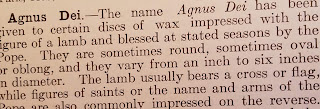On the feast of St. Agnes of Rome, here is the history of a little family treasure that was unknown until today.
On weekdays we often attend Mass with our diocesan Latin Mass priest. We have been reading aloud the wonderful novel Fabiola by Cardinal Wiseman and St. Agnes has become a family favorite. In his eloquent sermon on the virgin martyr, Father quoted the Introit:
"Behold, now she follows the Lamb, who was crucified for us, powerful in virginity, modesty her offering, a sacrifice on the altar of chastity."
Back at home, I looked up St. Agnes in our 1913 Catholic Encyclopedia while the children worked diligently on their math. I read through the biographical entry. My nine-year-old son who serves at the Latin Mass and is a budding Latin scholar, asked me if the Agnus Dei from the Mass could also be found in the encyclopedia. As I flipped to the page, my eye rested on the first "Agnus Dei" I found and I began reading aloud:
"The name Agnus Dei has been given to certain discs of wax impressed with the figure of a lamb and blessed at stated seasons by the Pope. They are sometimes round, sometimes oval in diameter. The lamb usually bears a cross or flag, while figures of saints or the name and arms of the Pope are also commonly impressed on the reverse."
A lightbulb went off- I stopped and asked my children if they had seen something like this before. Of course they had! My parents, converts to Catholicism, have long been collectors of various unidentified, religious articles that the children study and admire on visits.
I continued reading:
"We know that when we first hear of them (c. 820) they were made of the remnants of the preceding year's paschal candle(...) In the penal laws of Queen Elizabeth--"
(I give a dramatic pause as the children boo and hiss!)
"--Agnus Deis are frequently mentioned among other "popish trumperies" the importation of which into England was rigorously forbidden..."
So this is what that mystery wax seal was! We drove over to the grandparents' house and after a walk and a rosary, pulled out the magnifying glass. The little Latin scholar set to work trying to decipher the letters and numbers. The verdict is still out, look for an update.
The Catholic Encyclopedia writes: "The symbolism of the Agnus Deis is best gathered from the prayers used at various epochs in blessing them. As in the paschal candle, the wax typifies the virgin flesh of Christ, the cross associated with the lamb suggests the idea of a victim offered in sacrifice, and as the blood of the paschal lamb of old protected each household from the destroying angel, so the purpose of these consecrated medallions is to protect those who wear or possess them..."
As a convert to Catholicism and a more recent convert to the "Mass of all Ages", I never tire of discovering the rich treasures of the seemingly-lost Catholic Faith. Today, we felt the sweet presence of the little lamb of God, Saint Agnes. These red rhododendrons are for her.




Sweet post. A family treasure indeed!
ReplyDeleteThanks for reading Marie-Jacqueline!
Delete